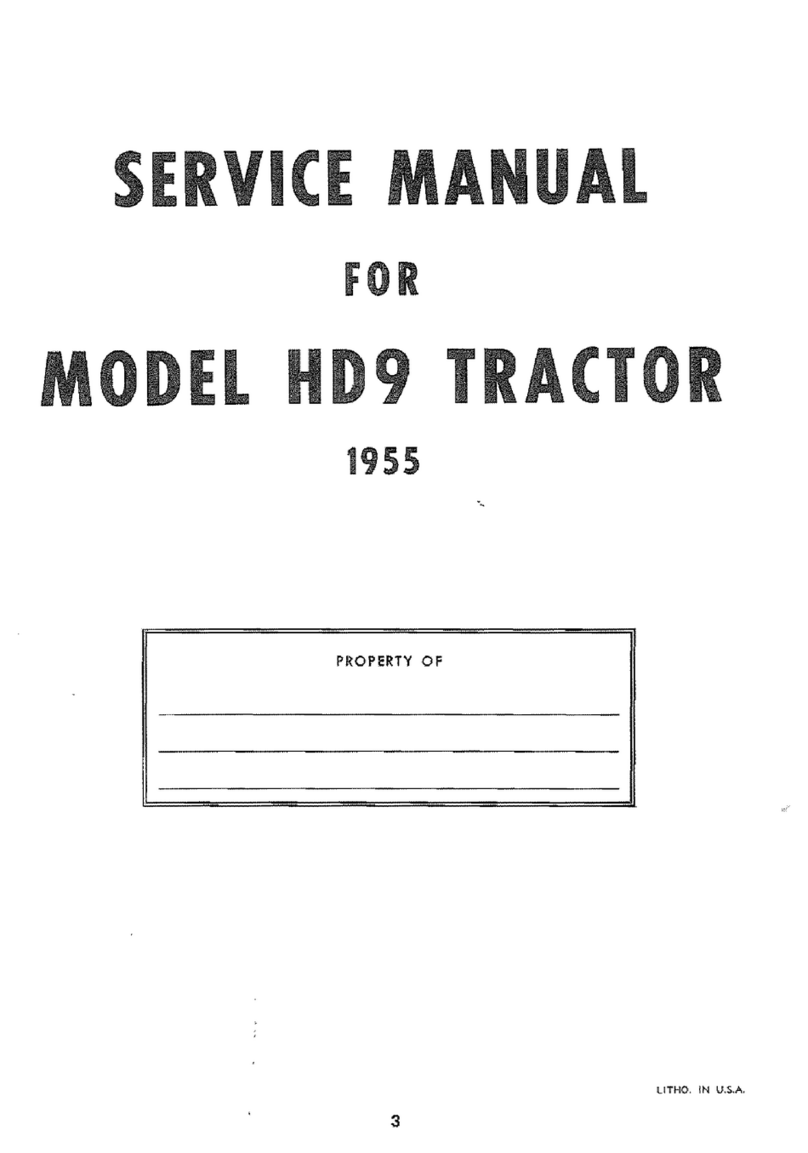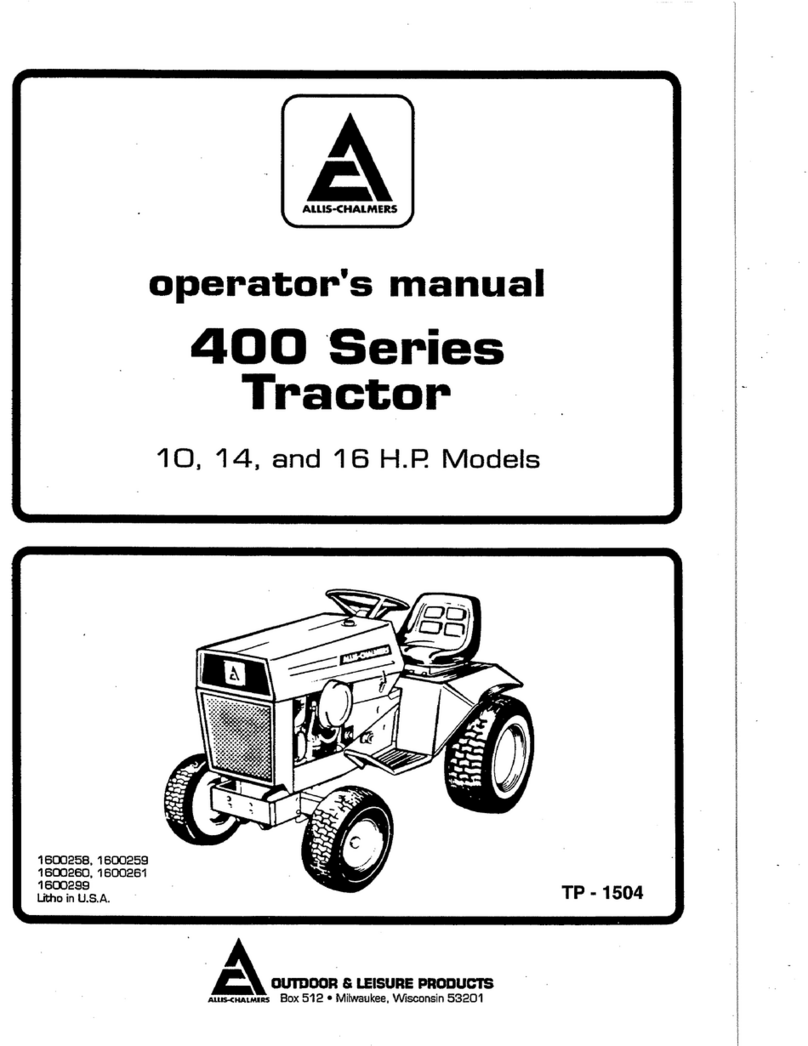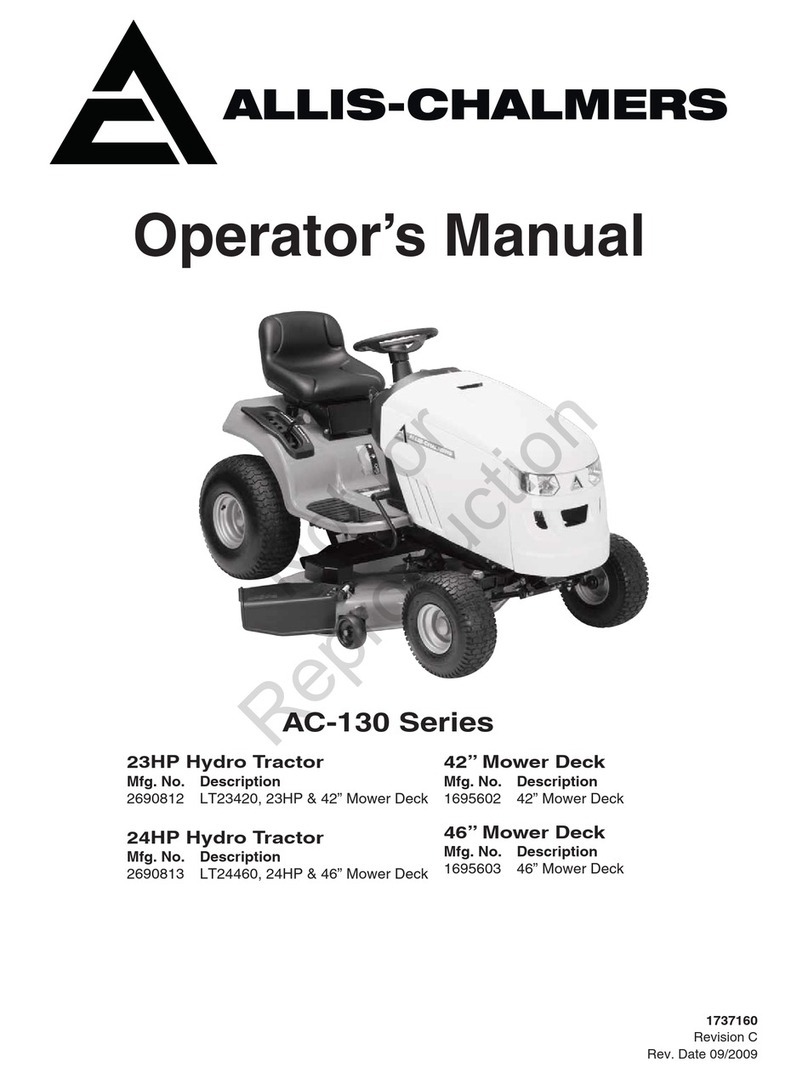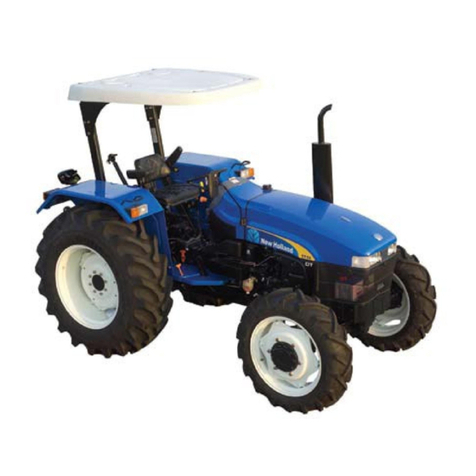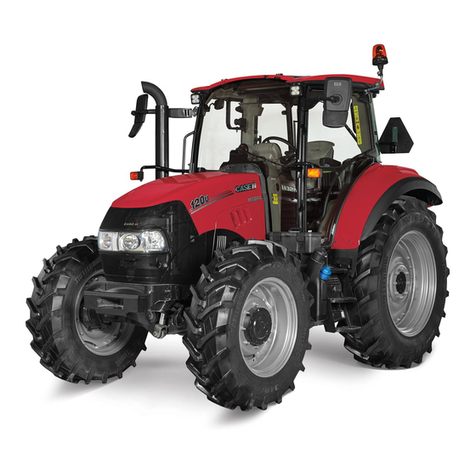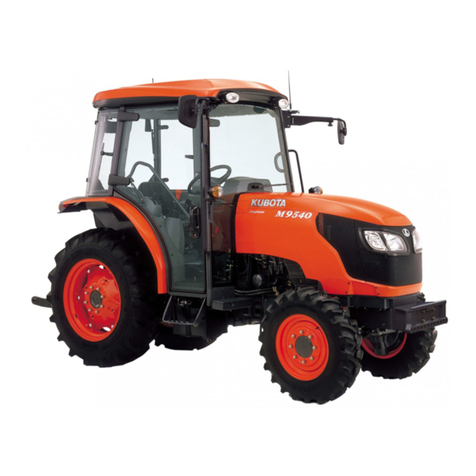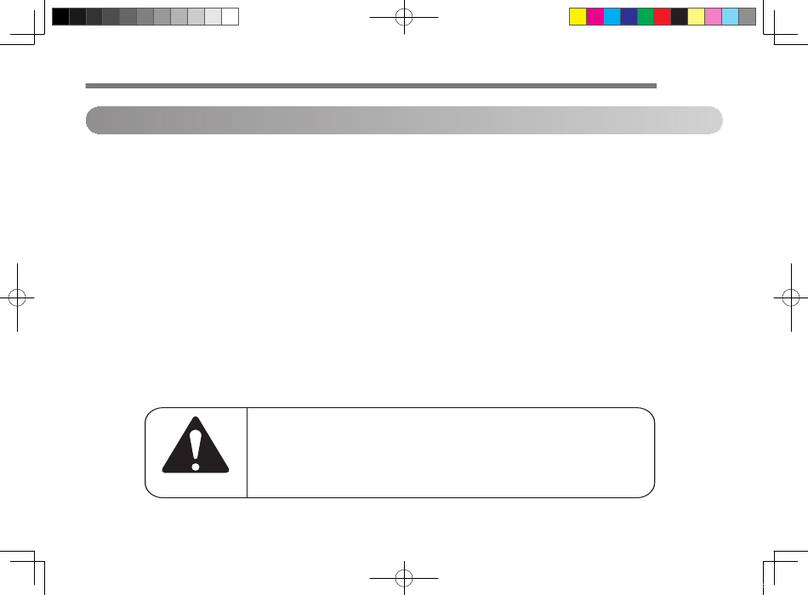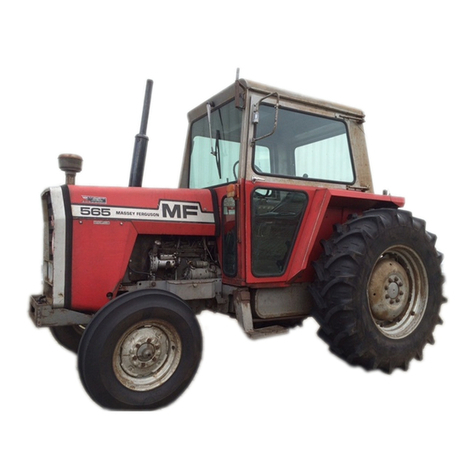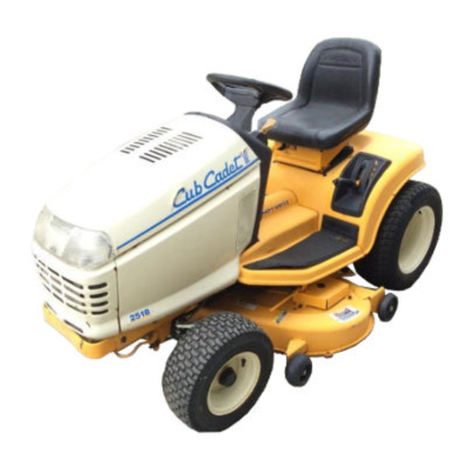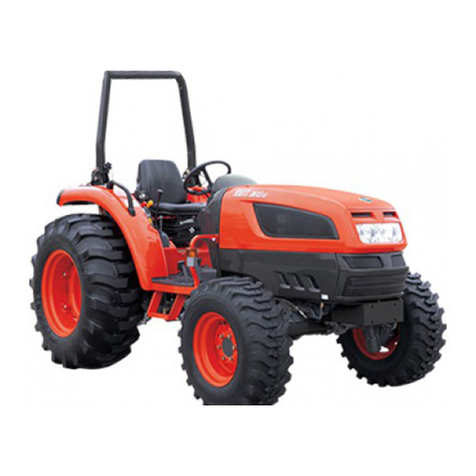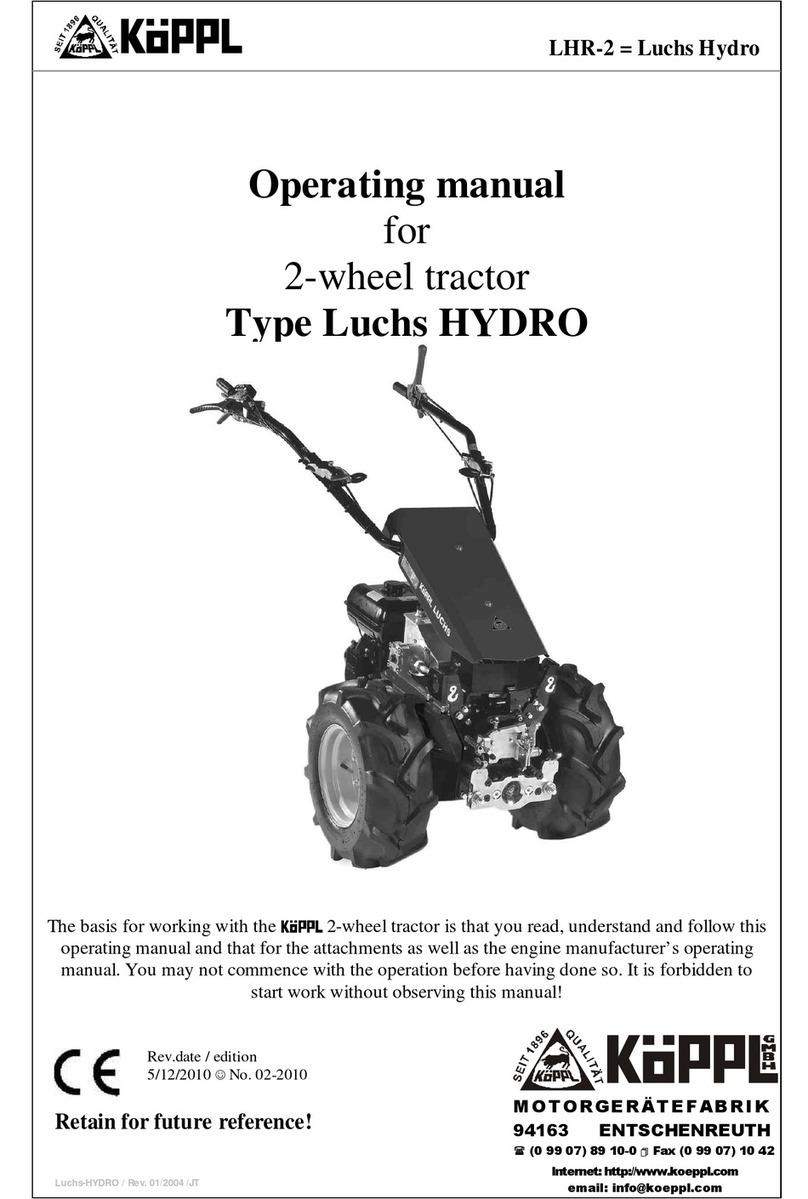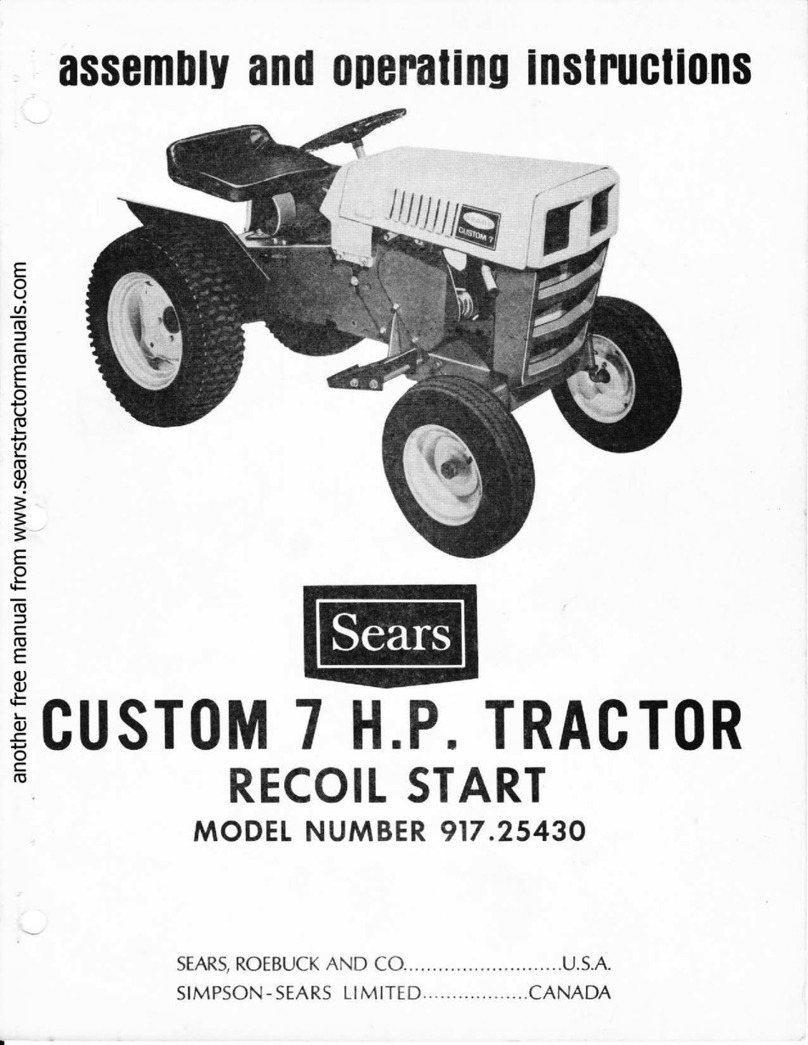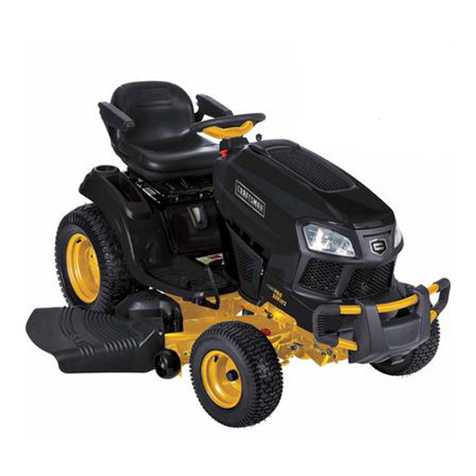Allis-Chalmers WD Use and care manual


FOREWORD
The instructions given in this book cover the operation of the
Allis-Chalmers Model “WD” Tractor. A close adherence to
these instructions will result in many hours of trouble-free
operation and a longer operating life for the unit.
This book is written for the purpose of giving the operator
essential information regarding the day-to-day care, lubrication
and adjustment of the machine. Economical operation will be
insured if these instructions are followed.
Many Allis-Chalmers owners employ the dealer’s Service
Department for any work other than routine care and adjust-
ments. This practice is encouraged as our dealers are kept
well informed by the factory regarding advanced methods of
servicing Allis-Chalmers products and are equipped to render
satisfactory service.
*
*
*

INDEX
BRAKES
Adjustment .............
26
Operation .............. 26
Type. ................ 26
CLUTCHES
Engine Clutch ...........
26
Transmission Clutch ........
26
DIAGNOSING ENGINE DIFFICULTY. . 28
DRAWBAR ...............
27
ELECTRICAL SYSTEM
Ammeter ..............
19
Battery ............... 22
Cut-out Relay. ...........
21
Fuse. ................
19
Generator. .............
21
Lights. ............... 20
Light Switch
&
Generator Control .
19
Starter ...............
21
Wiring Diagram
&
Information. .. 20
FRONT WHEELS
Adjustment ............. 25
Adjustable Wide Front Axle .... 25
Lubrication ............. 25
Maintenance ............
2 5
Single Front ............ 25
Spacing ............... 25
Tires ................ 25
Wide Front Axle .......... 25
FUEL SYSTEM
Carburetor .............
17
Fuels ................
16
Fuel Filter .............
16
Manifolds ..............
16
GENERAL INFORMATION
Fuels ................
5
Lubrication .............
5
Manifolds ..............
5
GENERAL SPECIFICATlONS .....
4
GOVERNOR. ..............
17
HYDRAULIC SYSTEM
Adjustments and Operation
Delayed Lift ...........
Drawbar Control. ........
Hold Position ..........
Lift and Lower. .........
Linkage. .............
Lubrication ............
Rams. ...............
Remote Ram. ...........
32
33
33
32
30
30
34
34
IGNITION SYSTEM
Magneto ..............
Spark Plugs ............
18
18
LUBRICATION
&
SERVICE CHART. .
6
LUBRICATION
&
SERVICE GUIDE . .
8
OPERATING INSTRUCTIONS
After Engine has Started-Check. .
Belt Pulley. ............
Break-in Period ..........
Hand Cranking ...........
Light Switch
&
Generator Control.
Operating Tractor .........
Power Take-off ..........
Starting Engine ..........
Stopping Engine ..........
Stopping Tractor. .........
Temperature Gauge ........
11
12
10
12
11
11
12
10
11
12
11
RADIATOR
&
COOLING SYSTEM
Anti-Freeze Solution .......
Draining Cooling System .....
Fan Belt Adjustment. .......
Operating Temperature ......
Pressure Radiator. ........
Radiator Capacity .........
Radiator Shutter ..........
Temperature Gauge ........
REAR WHEELS
Hydromatic Tractor Tires. ....
Tires. ...............
To Remove Rim from Wheel ...
Tread Adjustment .........
15
15
15
14
14
14
14
14
23
23
24
24
SAFETY SUGGESTIONS ........
13
SEAT. .................
27
STORAGE OF TRACTOR .......
29
VALVE TAPPET CLEARANCE. , . .
17
4
3

GENERAL SPECIFICATIONS
ENGINE :
Number of Cylinders . . . . . , , . . 4
Bore . . . . . . . . . . . . . . . . . 4”
Stroke . . . . . . . . . . . . . . . . . 4”
R.P.M. . . . . . . . . . . . . . . . 1400
Firing Order . . . . . . . . ,l-2-4-3
Piston Displacement . . . . 201 Cu. In.
Compression Ratio (Gasoline)
5-l/2
to 1
(Low Octane Fuel). . .
4-l/2
to 1
MAGNETO:
Impulse Coupling . , . . . . . Automatic
Lag Angle . . . . . . . . . . 30 degrees
Timing Advance . . . . . . . 30 degrees
Point Gap . . . . . . . . . . . . ..020”
Spark Plug Size . . . . . . . . . . 14mm
Spark Plug Point Gap. , . .030” to .040”
Spark Plug Heat Range
Gasoline . . . . . . . Autolite AN 7
or equivilent
Spark Flug Heat Range
Low Octane . . . . . . . Autolite A9
or equivilent
TRANSMISSION: (Selective Sliding Gear)
First . . . . . . . . . . . .
2-l/2
MPH
Second, . . . . . . . . . . .
3-l/2
MPH
Third . . . . . . . . . . . .
4-3/4
MPH
Fourth . . . . . . . . . . . . .
.9
MPH
Reverse . . . , . . . . . . . . . 2 MPH
ENGINE CLUTCH: (Spring Loaded)
Single Plate
-
Dry Disc
Diameter . . , . . . . . . . . . . .10”
TRANSMISSION CLUTCH: (Over Center)
Optional
Double Plate
-
Wet
Diameter . . . . . . . . . . , . . . . 7”
BELT PULLEY: (Optional)
Diameter . . . . . . , . . . . . . .9”
Face . . . . . . . . . . . . . . .
6-l/2”
RPM at 1400 Engine Speed . . . . . 1260
BRAKES:
Enclosed Contracting Type,
Foot Operated
RADIATOR:
Capacity. . . . . . . . . . . .
3-l/2
Gal.
OIL SUMP:
Capacity . . . . . . . . . . . .6 Quarts
TRANSMISSION, DIFFERENTIAL
AND CLUTCH
Capacity . . . . . . . . , . , . 17 Quarts
(18 quarts with P.T.O. Installed)
FINAL DRIVE GEARS:
Capacity
-
Each . . . . . . . . . 1 Quart
F UEI. TANK:
Capacity . . . , . . . . . . . . . .15 Gal.
Auxiliary Tank . . . . . . . . . . 1 Gal.
WHEEL TREAD:
Rear . . . . . . , . . . . . ,56” to 90”
TIRE SIZE:
Front . . . . . . . . . . . . . 5.50 x16”
Rear... . . . . . . . . . . . . 11x28
TIRE PRESSURE:
Front. . . . . . . . . . . . . . .
.28
lbs.
Rear . . . . . . . . . . . . . .12 lbs.
BATTERY:
6 Volt -- 15 Plate -- 95 Ampere Hour
HYDRAULIC PUMP (Optional)
Capacity . . . . . . . . . . . . . 5 Quarts
Lift Rams . . . . . . . Diameter
l-1/4”
Remote Ram . . . . . Diameter
l-3/4”
POWER TAKE-OFF
RPM at 1400 of Engine . . . . . . . 548
STEERING: (Semi-Reversible)
Ratio.. . . . . . . . . . . . . .
.12to1
HEIGHT
Overall . . . . . . . . . . . .
81-l/2”
Height of top of Steering Wheel . . , 68”
Wheel Base . . . . . . . . . . . . . 88”
Overall Length . . . . . . . . . . . 128”
Turning radius
-
With Brake . . . , 8’
The Allis-Chalmers Manufacturing Company reserves the right to make changes in the
above specifications or to add improvements at any time without notice or obligation.
4

GENERAL INFORMATION
LUBRICATION
IT PAYS TO PAY A LITTLE MORE FOR QUALITY LUBRICANTS
It has long been recognized that the life of a lubricated, therefore, it will cause undue wear
tractor is largely determined by the kind of and engine sluggishness. Oil that is too light
lubrication it receives. Therefore always use will not form a protective film between moving
oil and grease of high quality, manufactured parts. For best results and to assure lubrica-
by a dependable oil company who has established
tion between snug fitting parts refer to lubri-
a reputation for quality products and whose cants recommended in Lubrication Guide.
success depends on maintaining such quality.
In addition to using high quality oils it is also
Some parts need more frequent lubrication than
necessary to use oils of proper viscosity. Oil other parts. Lubrication intervals outlined in
that is too heavy cannot reach all points to be LUBRICATION GUIDE pages 8 and 9 should
be followed closely.
FUELS
FOR ECONOMY AND PERFORMANCE USE FUELS SPECIFIED FOR YOUR ENGINE
Engines for Model
"WD"
Tractors may be secured equipped to burn the above fuels are designated
with either a high or low compression ratio.
by the letter
"K"
following the engine serial num-
Each is designed to efficiently burn a particular ber located on the left rear of engine block.
class of fuel. For best performance use the (Example: WD110650 KA)
class of fuel for which the engine was designed. High compression engines are equipped to
Standard compression engines are equipped to burn gasoline only. For average loads use
burn distillate, tractor fuel or low octane gaso- 60 octane gasoline or higher. For continued
line. These fuels should have the following heavy loads use 70 octane gasoline or higher.
specifications: Gravity -- 38 or higher; End These engines are designated by the letter
Point --
525O
or less; Octane Rating -- 30 or
“G”
following the engine serial number,
(Ex-
more; Gasoline
-- 60 octane or higher. Engines ample: WD110650 GA)
MANIFOLD
Allis-Chalmers tractors are supplied with one uses gasoline only.
of two styles of manifolds. When using the two fuel manifold install the
The two fuel manifold is used with standard cover marked "K" when burning tractor fuel
compression engines and can be used for trac- or distillate. Install the cover marked
‘G”
tor fuel or gasoline. The gasoline manifold when using gasoline.
is supplied on high compression engines and

1
STEERING
SP!NDLE
SHAFT
7.-1
8.
FRONT WHEEL
19
STEERING WORM
AND GEAR
WATER PUMP
8.-
15
FILLER CAP
20.
GENERATOR . STEERING SHAFT
BEARING
9. BREATHER
10. AIR CLEANER
4 CLUTCH SHAFT
FUEL FILTER
16.
FINAL DRIVE
2. UNIVERSAL JOINT
8.-l
5. O
IL
SUMP
22.
OIL FILTER
Ii1
CLUTCH RELEASE
BEARING
5.
PULLEY
1.
HYDRAULIC PUMP
21.
TRANSMlm
~~
__.
_.
.,
TRANSMISSION AND DIFFERENTIAL
I:SlON
CLUTCH.
LUBRICATION AND SERVICE CHART.’
6

LUBRICATION AND SERVICE CHART
(Cont’d.)
-I
7

LUBRICATION AND SERVICE GUIDE
DAILY CHECK
Lubricate items 1 thru 6 with Chassis Lubricant.
1. STEERING SPINDLE SHAFT
2. UNIVERSAL JOINT
3. LOWER STEERING SHAFT BEARING.
4. CLUTCH SHAFT
5. PULLEY (when in use)
6. ENGINE CLUTCH RELEASE BEARING
-
Lubricate every 10 to 20 hours with chassis
lubricant. Do not over grease. Fitting can
be reached by removing small cover at
bottom of clutch housing. Lock clutch pedal
forward to locate fitting
50
it may be reached
by
gun.
7. FRONT WHEELS
-
If wide front axle is used
lubricate four king pins. (See 30 Day Check.)
8. OIL SUMP
-
Capacity 6 quarts. Maintain
oil level to full mark on oil gauge rod. When
using low octane fuel drain to level of drain
cock located on right side of oil sump, every
10 hours and refill with fresh motor oil.
Above
90°F.
use SAE 40
Above
32’F.
use SAE 30
Above lOoF. use SAE 20W
Below lOoF. use SAE
1OW
9. BREATHER CAP
-
Wash in gasoline and dip
in motor oil
-
throw off excess oil before re-
placing. Under extremely dusty conditions,
service the breather cap twice daily.
10. AIR CLEANER
-
Clean and refill oil cup.
Fill to level mark using motor oil of the
same viscosity as used in oil sump.
Under extreme dusty conditions service air
cleaner twice daily. Each season remove
the entire air cleaner and clean main body
and element thoroughly. Keep all connections
air tight.
11. HYDRAULIC PUMP
-
Oil used in hydraulic
pump must not foam. Check daily and keep
filled to high mark on bayonet gauge or to top
of filler neck on tractor not equipped with
bayonet gauge. Filler plug is upper front
plug on torque tube. NOTE: This same oil
also lubricates belt pulley bearings and
gears. Change oil twice a year.
Amagnetic drain plug is located at the bot-
tom of the housing. This plug should be
cleaned periodically. To completely drain
pump the pump control housing must also be
drained.Above
45OF.
use SAE
2OW
Below 45OF. use SAE
1OW
12. RADIATOR
-
Capacity
3-l/2
gallons. Drain
cocks are located at bottom of radiator and
engine block ahead of carburetor.
WEEKLY CHECK
13. RIGHT HAND BRAKE PEDAL
-
Lubricate
with chassis lubricant.
14. ENGlNE CLUTCH PEDAL
-
Lubricate with
chassis lubricant (not shown).
15. OIL SUMP
-
Drain and refill with fresh oil
every 60 hours when using gasoline. When
using low octane fuel drain completely and
refill every 40 hours. Drain plug is located
at bottom of oil sump. Keep filled to full
mark on bayonet gauge.
Above
90°F
use SAE 40
Above 32OF use SAE 30
Above lOoF use SAE 20W
Below lOoF use SAE
1OW
16. FINAL DRIVES
-
Capacity
l-3/4
quarts each.
Keep filled to level plug, For temperatures
above
32OF.
use SAE 140 gear lubricant; for
temperatures below 32’F. use SAE 90. Drain
and refill twice a year.
17. BATTERY
-
Electrolyte solution should be
l/4
inch above separators.
30 DAY CHECK
18. FRONT WHEELS
-
Clean and repack with
No. 2 wheel bearing grease every 30 to 60
days. (Applies to all types of front wheels)
19. STEERING WORM AND GEAR
-
Check every
30 to 60 days. Remove cover from top of
front support, maintain oil level so worm
gear is one-third submerged. Use SAE 140
gear lubricant. NOTE: With wide front
axle and single front wheel use SAE #250.
20. GENERATOR
-
Lubricate with motor oil of
same viscosity as used in oil sump at pre-
vailing temperature. Two or three drops is
sufficient.
21. TRANSMISSION, DIFFERENTIAL AND
TRANSMISSION CLUTCH
-
Capacity 17
quarts. Keep filled to level plugs. Use
+SAE 80EP all year. Drain plugs are
located on bottom of transmission, bottom
of differential and bottom of clutch housing.
Drain and refill twice a year. When power
take-off is installed on transmission add one
8

AIR CLEANER
A clean air cleaner adds life to your engine.
Service the air cleaner as mentioned in Item
number 10, Use the same viscosity oil as used
in the engine oil sump according to the pre-
vailing temperature. Keep the oil cup filled
to the proper level at all times. Do not dilute
oil or use used crankcase oil. The efficiency
/
of cleaner
depends
on the proper viscosity oil.
LUBRICATION AND SERVICE GUIDE (Cont’d.)
extra quart. Fill all three compartments 22. OIL FILTER
-
Replace when oil begins to
through transmission filler plug. darken. Replacement is usually necessary
after 200 hours when operating on gasoline
*his
oil is sold under varied listings. Any oil
following U.S. Army specifications of
2-105B
80 viscosity transmission oil is satisfactory.
and after 100 hours when operating on low
octane fuel.
FILTER ELEMENT
EAFFL OIL LEVEL
BAFFLE RETAINER
AIR CLEANER
BREATHER
Service the breather cap daily as mentioned in
Item Number 9. If breather should become
clogged with dirt, pressure will be created in
the crankcase, causing oil leaks.
OIL FILTER
Insure your engine life by regular replacement
machine packed, to a specific density and supplied
of filter. The oil filter is a highly efficient unit
by the Allis-Chalmers Mfg. Co. for the protection
for the purpose of filtering abrasive particles
of your engine.
from the crankcase oil. NOTE: A slight decrease in oil pressure is
The filter element consists of a metal container generally noted when a filter element is in-
packed with a special long thread filtering yarn.
stalled, until the element is thoroughly saturated
with oil.
CAUTION: Install only a new element which is

.
-.-“..
-._.
_
OPERATING INSTRUCTIONS
HYDRAULIC CO
GEAR SHIFT LEVER
AMMETER
\
BREAK IN PERIOD
-
The tractor engine is as-
sembled and tested and ready for work, how-
ever for best results operate tractor under
medium loads for the first 10 to 20 hours of
operation.. If possible it should be operated
at full governed
r.p.m.
of engine. If necessary
use a lower gear to keep from overloading
engine. In cold weather the oil should be
changed after the first 20 to 30 hours of
operation. However if the proper temperature
is maintained at all times the lubricating
interval outlined in lubrication guide may be
followed.
STARTING ENGINE
1. Before starting tractor make certain that all
points of care and lubrication outlined under
daily, weekly or 30 day check have been ser-
viced as specified.
2. Close radiator shutter by turning screw crank
located on right hand side of tractor.
3. If gasoline is to be used open valve under
large tank. If low octane fuel is used open
valve under small tank. Move throttle control
lever down about one fourth of quadrant.
Place gear shift in neutral position. In cold
weather hold clutch pedal down until engine
starts to relieve starter load.
4. Pull out magneto switch on instrument panel.
5. Pull carburetor choke rod located at right
side of steering column.
6. Pull out on starter pull rod located on left
side of steering column. Engage starter
firmly to insure good switch contact. Release
immediately when engine starts, When engine
has turned one complete turn, push choke rod
forward, If weather is extremely cold more
choking may be necessary.

AFTER ENGINE HAS STARTED
-
CHECK
1. OIL PRESSURE GAUGE. When operating
engine look at oil gauge at frequent intervals
to make certain oil is being circulated by
pump. The indicator needle should always
remain near the O.R. or M. in the word
NORMAL when the engine is hot and running
at its normal speed. A slight decrease will
be noted when engine idles. Do not operate
unless gauge registers,
2. THE TEMPERATURE GAUGE needle should
operate in the green portion of gauge, and
temperature should be maintained by shutter
adjustment.
3. THE LIGHT SWITCH
&
GENERATOR CON-
TROL is located on the instrument panel, To
turn on lights pull switch to first notch. The
generator has two charging rates, with switch
pushed all the way in the lights are off and
rate of charge about 3 amperes as indicated
on ammeter, when pulled to first notch lights
are on and charging rate remains about 3
amperes. When switch is pulled all the way
out about 10 to 13 amps. The high rate of
change should be used only when the battery
is in a partially discharged condition.
In
most tractor operation the trend will be to
overcharge the battery.
STOPPING ENGINE
-
Place throttle in idling
position and allow engine to idle a few mo-
ments. Shut off by pushing in on magneto
switch. If using low octane fuel close valve
under fuel tank and allow engine to run until
it stops from lack of fuel. This will drain
the carburetor so gasoline may be used for
starting.
OPERATING TRACTOR
-
The clutch is provided
for engaging or disengaging the power of
engine from the tractor. When using clutch
depress pedal fully and allow tractor and
clutch to come to a full stop before attempting
to shift gears. Reducing engine speed to low
idle before depressing clutch will help prevent
clashing gears. With the engine running, push
the clutch pedal forward to release clutch,
Hold in this position until the clutch stops
revolving. Move the gear shift lever to the
desired position as indicated on top of trans-
mission cover. Open throttle far enough to
avoid stalling. Release clutch pedal slowly to
avoid jerking. The transmission clutch is
provided to disengage the engine power from
the transmission and rear wheels, leaving the
power applied only to the P.T.O., hydraulic
pump and belt pulley, if used.
The transmission clutch is hand operated and
the lever is mounted to the right of the steer-
ing shaft support. Pushing lever forward
disengages clutch.
AMMETER
INSTRUMENT PANEL
When’using the belt pulley, the transmission
clutch should be engaged and the transmission
shifter lever placed in neutral position,
Easy turns may be made by simply turning
steering wheel to right or left as desired.
Foot brakes are provided for making ex-
tremely short turns. Turn steering wheel
in direction desired and then apply brake on
side towards which the tractor is being
turned. Do not attempt short turns when
traveling at high speeds. When using the
brakes for stopping, apply pressure to both
brakes so that the brakes are engaged evenly.
This will bring the tractor to an even stop
without skidding. The latch on brake lever
is conveniently located for locking the brake
in the engaged position to hold the tractor on
an incline, or for belt work.
Operate engine at full throttle or nearly full
throttle and select the desired transmission

OPERATING INSTRUCTIONS (Cont’d.)
gear to suit the work being done. To shift to
low or first gear with the gear shift lever in
neutral position, disengage clutch, move gear
shift lever to left and forward. Second from
neutral, left and back, third gear right and
forward, fourth gear to right and back. To
shift to reverse, push lever to extreme right
and back, always stop tractor before changing
gears. Severe overloads may be thrown on
engine if tractor is operated at reduced engine
speeds on heavy loads.
Adjust the
drawbar
height to recommended
height for the implement being drawn. The
drawbar should be placed as near in the
centerline of draft as possible. Rear wheel
weights are available for securing extra
traction on heavy loads.
STOPPING TRACTOR
-
Push clutch pedal for-
ward, allow tractor to stop or if necessary
apply brakes. Place gear shift in neutral
position, release clutch pedal.
HAND CRANKING
-
Push clutch pedal down and
engage
pedal
lock. Proceed as under “‘Starting
Engine . Engage crank grasping handle with
thumb on same side of crank as fingers.
Crank in quarter turns only, pulling
up
and
over. DO NOT ATTEMPT TO “SPIN’ EN-
GINE. When engine starts release clutch
pedal lock. Do not operate engine for long
periods with pedal locked forward.
OPERATING BELT PULLEY
-
Push clutch pedal
down and engage pedal lock. Loosen belt
pulley retaining screw and push pulley assem-
bly into the tractor. The dealer will stamp
an arrow on tractor frame and on pulley
tube. These arrows must be aligned to obtain
proper gear mesh. Tighten lock screw and
jam nut. Release clutch pedal, The clutch
pedal lock may be engaged when pulley is
stopped, however the engine should be stopped
if any work is to be done on the driven
machine.
OPERATING POWER TAKE-OFF
-
The power
take-off is used to furnish power to P.T.O.
driven machines and operates at a speed of
548 r.p.m. at 1400 r.p.m. of engine. The
speed of the P.T.O. remains at 548 regard-
less of what gear the tractor is operated in.
The P.T.O. is provided with a shift lever for
engaging or disengaging. To engage the
P.T.O., push the clutch pedal forward the
same as for shifting gears in the transmission.
Allow the clutch to stop and, if the tractor
is in motion, allow it to stop. Pull up on the
P.T.O. shift rod located
near
the steering
rod support. If the P.T.O. is engaged, do not
attempt to shift transmission gears until
12
P. T. 0. SHAFT
POWER TAKE-OFF
driven machine stops. This P.T.O. will keep
on running when the transmission clutch is
disengaged.

SAFETY SUGGESTIONS
Many hours of lost time and much suffering is
caused by the failure to practice simple safety
rules.
IT IS TOO LATE TO REMEMBER WHAT SHOULD
HAVE BEEN DONE AFTER THE ACCIDENT HAS
HAPPENED.
1. Do not fill fuel tanks when engine is hot or
while using a lantern or when smoking.
2. Do not attempt to spin engine when hand
cranking.
3. Do not attempt to oil or grease a machine
or tractor while it is in operation.
4. Do not wear loose fitting clothing that may
be blown into moving parts.
5. Keep all shields and guards in place.
6. Place gear shift lever in neutral position
when starting engine.
7. Machinery should only be operated by those
who are responsible and delegated to do SO.
8. Only one person -- the operator -- should be
permitted on tractor when tractor is in
motion.
9. The rate of travel on hillsides or curves
should be regulated so there is no danger
of tipping.
10. Do not remove radiator cap when engine
temperature is above 212 F.
11. Brakes should be properly adjusted.
12. Do not drive too close to the edge of a ditch
or creek.
13. Never operate your tractor in a closed
garage or shed.
14. When tractor is hitched to a stump or other
heavy load, always hitch to drawbar and
never take up slack in chain with a jerk.
15. Always keep tractor in gear when going down
steep grades.
16. Do not leave the engine running unattended
when any one is adjusting or repairing a
driven machine.
17. Do not attempt to operate tractor unless you
are in the driver’s seat.
18. Provide a first aid kit. Treat all scratches,
cuts, etc. with the proper antiseptic im-
mediately.
19. Always stop power take-off before leaving
driver’s seat.
20. Never stand between tractor and drawn
implement when hitching. Use an iron hook
to handle drawbar.
21. Do not put on or remove belt from belt pulley
while pulley is in operation.
22. Do not dismount from tractor while it is in
motion.

RADIATOR CAPACITY
3-l/2
gallons. Drain
cocks are located at bottom of radiator and on
engine block ahead of carburetor. Be sure to
remove cap when draining radiator.
TEMPERATURE GAUGE
-
The temperature
gauge is provided for a visual check on
operating temperature.
The gauge is marked in green indicating
normal with a range of
170°F.
to
220°F.
RADIATOR SHUTTER
-
The shutter is provided
for controlling the operating temperature of
engine. Turning the screw crank, located on
right hand side of radiator to the right, opens
the shutter.
Always close shutter before starting engine.
OPERATING TEMPERATURE
-
LOW ENGINE
TEMPERATURES CAUSE CONDENSATION--
SLUDGE AND CORROSION. KEEP ENGINE
HOT. Always close radiator shutter com-
pletely when engine is started and keep it
closed until engines reach operating temper-
ature (
170°F.
when using gasoline,
190°F.
when using low octane fuel). Then open
shutter amount necessary to maintain this
temperature,
If burning low octane fuels, operate
engine
on
gasoline until temperature reaches 190 F.
to 200
F.
before switching to low octane fuel.
This is readily done by shutting valve under
small tank and opening valve under large tank.
Never open valve under larger tank before
shutting valve under small tank as this will
mix the two fuels.
The minimum operating temperatures are
17OoF.
for gasoline and 190°F. for low octane
fuel. Strict adherence to these recommen-
dations will guard against excessive dilution
of lubricating oil, condensation and corrosion
14
PRESSURE RADIATOR
-
The pressure radiator
permits the use of a higher operating tempera-
ture. The cooling solution (pure water) will
not boil in the pressure radiator until a
temperature of
230°F.
is reached.
To remove the radiator cap, turn to the left
until it stops. Push down and continue to
turn to the left until the cap is released.
Do not remove the cap when the temperature
is above 212OF. as the cooling solution will
break into a violent boil which may splash onto
person removing cap.
=
TEMPERATURE GAUGE=
SHUTTER CONTROL HANDLE
..__.
RADIATOR AND COOLING SYSTEM
PRESSURE CAP STANDARD CAP
RADIATOR CAPS
Never pour cold water in a hot engine. Clean
rain or soft water should be used in the cool-
ing system if available. Hard or alkaline
water will form a scale which will impair
radiation if allowed to build up in the cooling
system. The use of washing soda will help
dissolve this scale. Where only hard water is
available, washing soda should be used at
intervals, and before the accumulation of
scale becomes heavy enough to scale off and
stop up radiator passages.

If soda is used’, mix with water thoroughly
before placing in radiator. Operate engine
about 2 hours. Drain and flush thoroughly
with clean water. Soluble oil is beneficial to
the cooling system. It will not prevent the
accumulation of lime but will retard such
formation. This water soluble oil may be
secured from your Allis-Chalmers dealer.
TO DRAIN COOLING SYSTEM
-
Open the drain
cock located on lower radiator outlet and the
drain cock on motor block ahead of carburetor.
CAUTION: In freezing weather be sure to
drain both places. Loosen radiator
cap
to
prevent system from air locking, which will
retard draining. Stay near tractor and make
sure system is completely drained.
ANTI-FREEZE
SOLUTION
-
If tractor is used
during freezing weather it is advisable to
fill the cooling system with anti-freeze
solution. If low octane fuel is used,
alcohol
should not be used in the cooling system,
because of its low boiling point. When low
octane fuel is used, a good grade of permanent
anti-freeze with a higher boiling point is
recommended because of the higher operating
temperature with this type of fuel.
FAN BELT ADJUSTMENT
-
To adjust loosen
the generator adjusting screw and move the
generator away from cylinder block until
about
1”
free movement at “A
"
is obtained.
Extreme tightness will reduce the life of the
belt, generator bearings and fan shaft bearing.
If fan belt bottoms in the
sheaves
indicating
belt wear the belt should be replaced.
ml.2 A
TNTNC
-

FUEL SYSTEM
.
FUELS FOR ECONOMY AND PERFORMANCE
USE FUELS SPECIFIED FOR
YOUR ENGINE.
Engines for Model “WD “Tractors may be
secured with either a high or low compres-
sion ratio. Each is designed to efficiently
burn a particular class of fuel. For best
performance use the class of fuel for which
the engine was designed.
Standard compression engines are equipped
to burn distillate, tractor fuel or low octane
gasoline. These fuels should have the fol-
lowing specifications: Gravity -- 38 or
higher: End Point
-
525O
or less; Octane
Rating -- 30 or more; Gasoline --60 octane
or higher. Engines equipped to burn the
above fuels are designated by the letter
“K”
following the engine serial number located
on the left rear of engine block (Example
WD-1106 50 KX.)
High compression engines are equipped to
burn gasoline only. For average loads use
60 octane gasoline or higher. For continued
heavy loads use 70 octane gasoline or higher.
These engines are designated by the letter
“G”
following the engine serial number.
(Example: WD-110650 GA.)
MANIFOLDS
-
The WD Tractor is supplied with
two types of manifolds.
The two fuel manifold is used with standard
compression engines and can be used for
tractor fuel or gasoline. The gasoline mani-
fold is supplied on high compression engines
and uses gasoline only.
When using the two fuel manifold install the
cover marked “K
”
when burning tractor fuel
or distillate. Install the cover marked
“G”
when using gasoline.
FUEL FILTER
-
The fuel filter is provided for
the purpose of keeping dirt and water from
entering the carburetor. However the best
results are obtained by using adequate fuel
storage and handling
facilties.
If the fuel is
kept free of dirt and water by use of clean
1containers and proper handling, the filter will
have little work to perform.
To clean the filter, shut off the fuel supply.
Loosen the bowl retaining nut and move bail
to one side.
Remove bowl, gasket and felt element. Note
which side of the element is up and be sure
to re-install with the same side up.
GASOLINE MANIFOLD
-
FUELFILTER
The element can be cleaned with ordinary
soap and water and a small stiff brush. The
element must be thoroughly dried before
re-installing.
It is well to carry an extra element on hand.
This will avoid delay in the drying operation.

CARBURETOR
-
The Zenith Model 161 Series
has three adjustments, one for controlling the
idling speed of the engine and two for correct-
ing changes in fuel and atmospheric condi-
tions.
To regulate idling speed of the engine
adjust the throttle stop screw on inner side
of the carburetor. For correct fuel mixture
at idling speeds of engine adjust needle valve
on front top of the carburetor. Turn needle
in for richer mixture. Normal setting is
approximately one and one-half turns out.
The main jet adjusting needle located on the
lower front of the carburetor body regulates
the fuel mixture at working speeds. Turn this
needle out for richer mixture. Normal setting
is two or three turns out depending on fuel
and atmospheric conditions. Always make
carburetor adjustment at normal operating
temperature.
The adjustments of the Marvel Schebler
Carburetor Model TS159 are the same as the
Zenith, except for the main jet adjusting
needle located on the front upper portion of
bowl. The normal operating adjustment is
approximately one and three eighths turns out.
VALVE TAPPET
Correct clearance between valve stems and
rocker arms should be maintained at all times.
To adjust clearance, turn engine with crank until
valvecloses and push rod is at its lowest posi-
tion.
Loosen valve adjusting screw lock nut and turn
screw until there is
.010"
clearance between
valve stem and rocker arm. Tighten lock nut
and recheck. The engine must be heated to its
normal operating temperature when making this
adjustment.
Lack of compression because of leaky valves
may be caused by either insufficient clearance
between rocker arms and valve stems or by the
collection of carbon on the valve stems or seats.
ZENITH CARBURETOR
MAINLOAD
ADJUSTING NEEDLE IDLING SPEED
ey
ADJUSTING SCREW
CHOKE LEVER
IDLING ADJUS
’
DRAIN COCK
-MARVEL SCHEBLER CARBURETOR
-
CLEARANCE
ADJUSTbiG SCREW
AND LOCKNUT
.010”
FEELER GAUGE
GOVERNOR
The engine speed is adjustable by throttle only.
To ensure good governor action it is important to
The governor, of the variable speed type, will have all linkage from governor to carburetor,
control the engine speed within the range of low work freely.
idle and 1725 r.p.m.
17

IGNITION SYSTEM
SPARK PLUGS
-
The spark plugs should be
removed every 200 hours of operation, cleaned
and the points respaced. The point gap should
be set from .030” to .040”. Make this ad-
justment by bending the outside electrode.
Never bend center electrode.
CAUTION: Failure to service spark plugs
as recommended, causes a severe bverload to
be placed on magneto.
For gasoline use autolite AN7 or equivalent.
For low grade fuel use autolite A-9 or
equivalent. Incorrect plugs are shorter lived
and cause poor engine performance.
Spark plug gap should be set properly; gap
too wide will cause missing on heavy loads
and lack of power.
Gap too narrow will cause missing, poor
idling and engine to die at slow speed.
The spark plugs and cables should be main-
tained in good condition and free of dirt and
grease.
MAGNET0
-
To time the magneto
-
Crank engine
until No. 1 piston is approaching top center
on its compression stroke and mark F or
firing mark appears in center of inspection
opening in bottom of clutch housing.
The compression stroke of No.
1
piston can
be determined by removing the spark plug
placing thumb in spark plug hole. Crank
slowly until air is forced past thumb.
The
mark F on flywheel will be very near the
inspection opening at this time. Turn until
centered.
I
-
SPARK PLUG ADJUSTMENT
Remove the distributor compartment cover
from the magneto that is retained by two
screws. Turn magneto impulse coupling
counter-clockwise until the rotor contact lines
up with the timing lug, located in upper left
hand corner of distributor compartment.
Couple magneto to engine. If rotor does not
exactly line up with lug, turn magneto on
engine until it does. The slotted holes in
mounting bracket are provided for this
pur-
NO. 1
ROTOR\
CONDENSER
K”l”K
wwt
PINION
&
ADJUSTING SCREW
pose.
OTOR VENTILATING HOLES
Attach number one spark plug wire to upper
terminal nearest cylender block. number two
DISTRIBUTOR CAP
FMX MAGNETO
to upper terminal farthest from block, number
four to lower terminal farthest from block, four screws. If contact points are pitted or
and number three in remaining terminal. In pyramided, file smooth with a fine cut file.
event of difficulty in the ignition system, plugs, If points are worn or badly pitted they should
wires having been checked, remove the
dis-
be replaced. Points should have .010" sepa-
tributor compartment cover held in place by ration when breaker points rest on high side of
18

cam. Points may be adjusted by loosening
lockscrews and turning adjusting screw.
Reassembling distributor cap to magneto
involves meshing of rotor pinion with dis-
tributor gear as follows: The marked tooth
of rotor drive gear (beveled tooth) must mesh
with tooth marked
“G
"
on rotor gear, If
gaskets are broken they must be replaced.
Make sure the vent holes are open in rotor
compartment. If these holes become plugged,
the magneto will not be ventilated. The mag-
neto was permanently oiled at factory and
needs no further lubrication.
For difficulties other than above mentioned
remove the magneto and take it to the nearest
authorized service station for check up and
repair.
ELECTRICAL SYSTEM
AMMETER
-
The ammeter indicates the charging
or discharging rate of battery. If ammeter
should register discharge
,with
lights off,
disconnect the battery cable, to prevent the
discharge of battery, until the difficulty is
located and corrected. Such a condition is
usually caused by a worn or frayed wire
making a short circuit or by cut-off relay
points being stuck together.
If ammeter fails to show a charging rate one of
the following may be the cause:
1. Loose or corroded wire connections.
2. Broken wires
3. Faulty ammeter.
4. Oily or g
ummy generator brushes or com-
mutator.
5. Worn generator brushes.
Commutator and brushes can be cleaned with
grade “00” sandpaper. (Do not use emery cloth.)
LIGHT SWITCH
&
GENERATOR CONTROL
-
The
generator has two charging rates. These are
controlled by the light switch.
When the light switch is pushed all the way
in, the lights are off and the charging rate is
about 3 amperes. When the switch is pulled
out to first notch the lights are on and the
charging rate remains about 3 amperes.
When the light switch is pulled all the way
out the lights are off and the charging rate
is increased to about 10 to 13 amperes. The
high rate of charge should only be used when
the battery is in a partially discharged condi-
tion. In most tractor operations the trend will
be to overcharge the battery.
FUSE
-
The light circuit is provided with a
20 ampere fuse. This fuse is located on the
inside-of the instrument box.
t-
Y-
AMMETER
NET0
RATE CONTROL SWITCH
INSTRUMENT PANEL
19

ELECTRICAL SYSTEM (Cont’d.)
LIGHTS
-
The head lights are adjustable in or
out and may be adjusted up or down, by
loosening the retaining thumb screw and
adjusting the lights to the desired position.
TAIL LIGHT,
WD TRACTOR WIRING DIAGRAM
WIRING DIAGRAM
WIRING DIAGRAM
&
INFORMATION
-
By re- #3
-
Magneto ground switch to ground.
ferring to the diagram the wires may be (White with black tracer)
placed in position correctly. The wires are #4
-
Light switch to headlight.
identified by either colors or numbers listed (Red with white tracer to junction;
below and may be checked as follows: black to light)
#l
-
Discharge side of ammeter to cutout
terminal (Black with white tracer).
#2
-
Resistor to generator field terminal.
(Green with white tracer).
#5
-
Charge side of ammeter to starter
(black). Short natural color with red
tracer wire goes from discharge side of
ammeter to fuse at terminal
"B"
Tail
light wire, black is connected to light
switch on terminal marked ‘S”.
Table of contents
Other Allis-Chalmers Tractor manuals
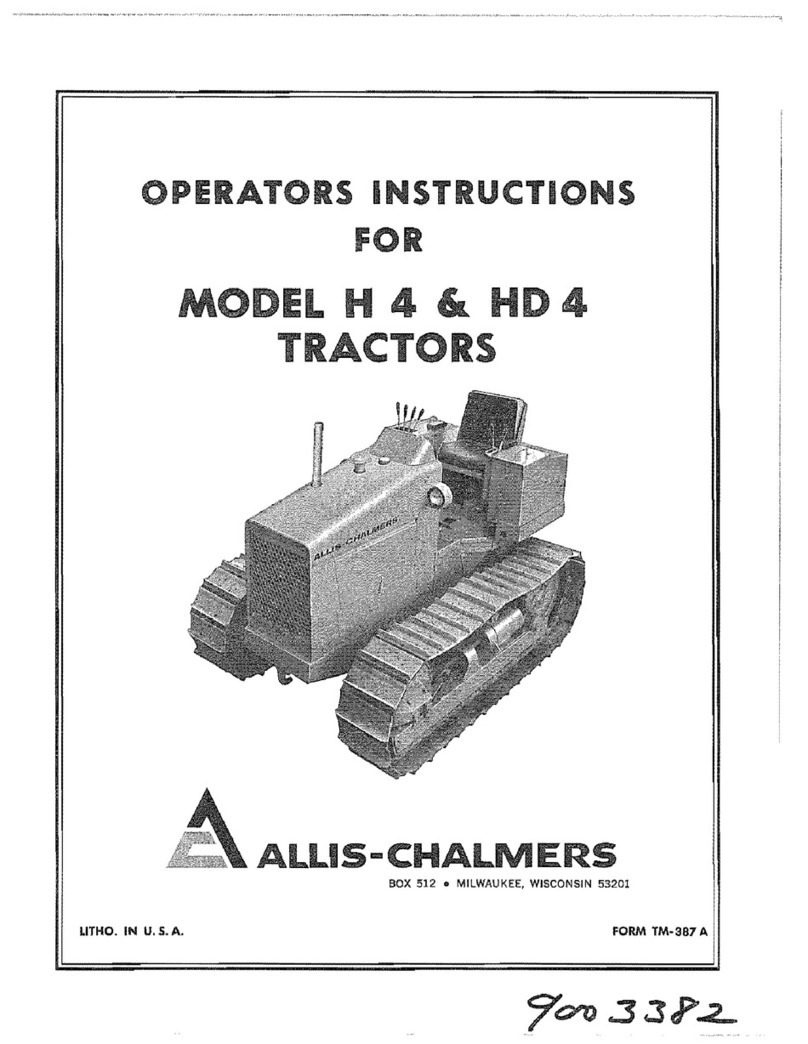
Allis-Chalmers
Allis-Chalmers H 4 Specifications
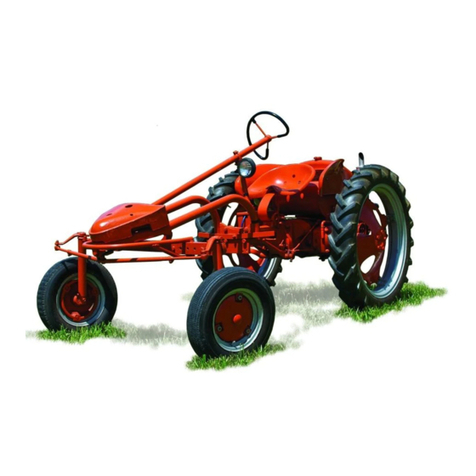
Allis-Chalmers
Allis-Chalmers G User manual
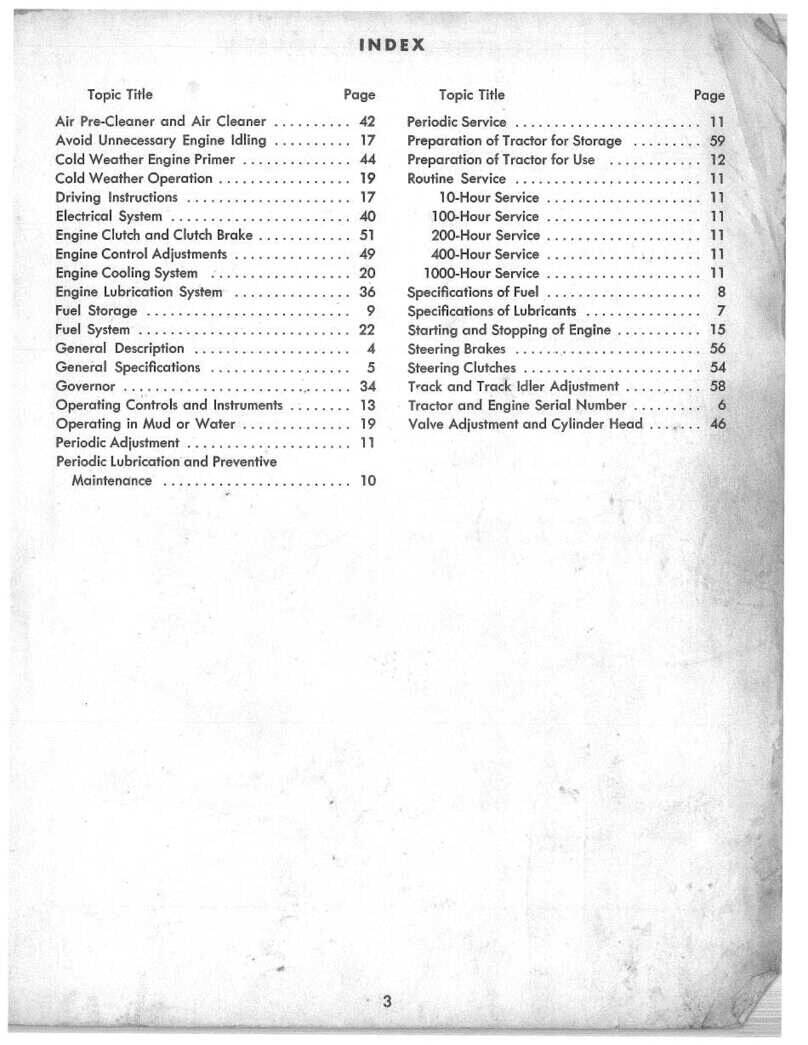
Allis-Chalmers
Allis-Chalmers HD 6B User manual
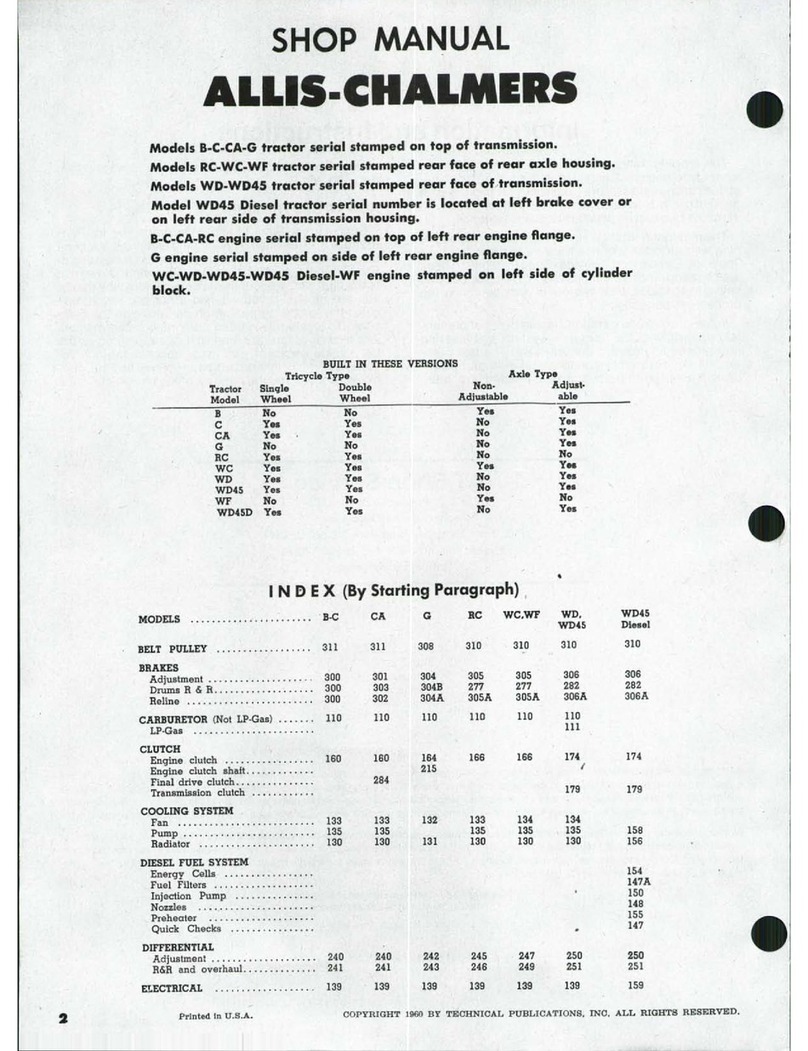
Allis-Chalmers
Allis-Chalmers B Install guide
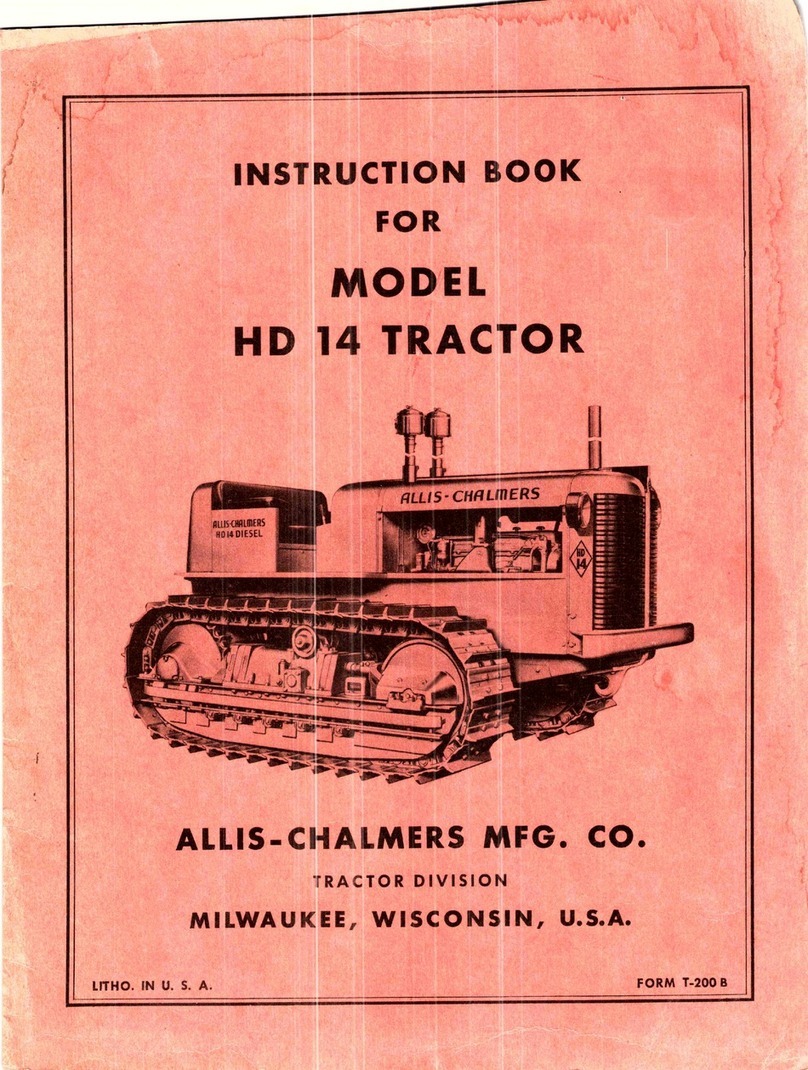
Allis-Chalmers
Allis-Chalmers HD-14 User manual
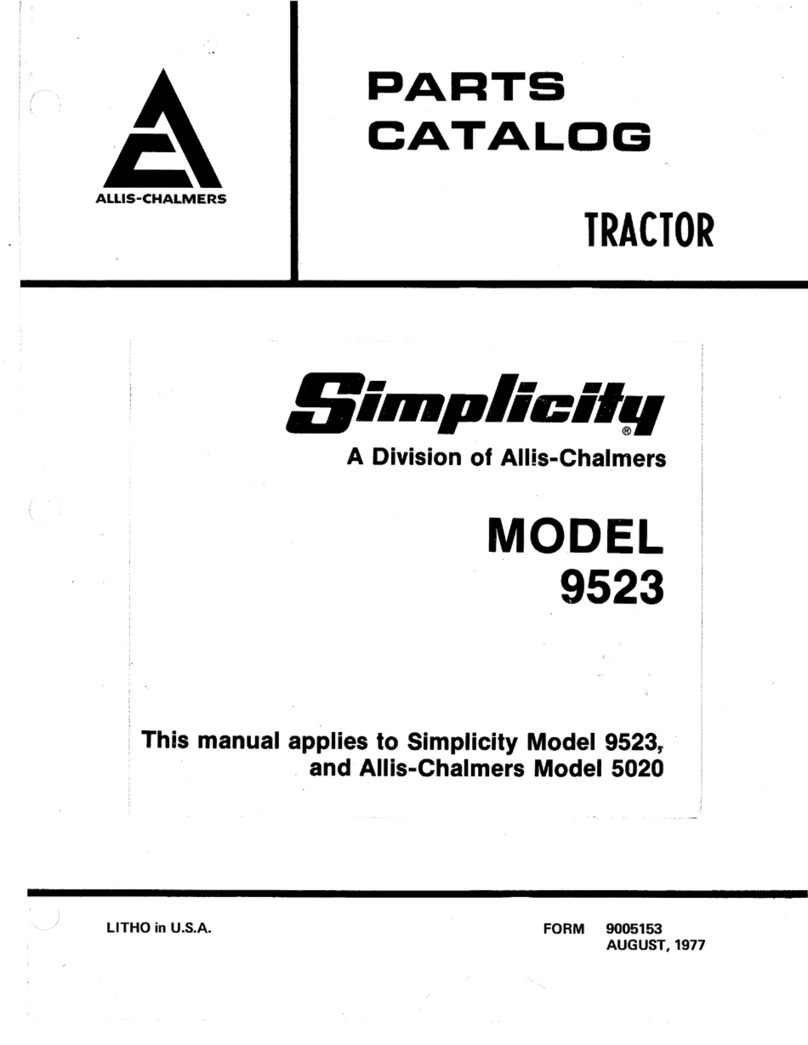
Allis-Chalmers
Allis-Chalmers Simplicity 9523 Instruction Manual
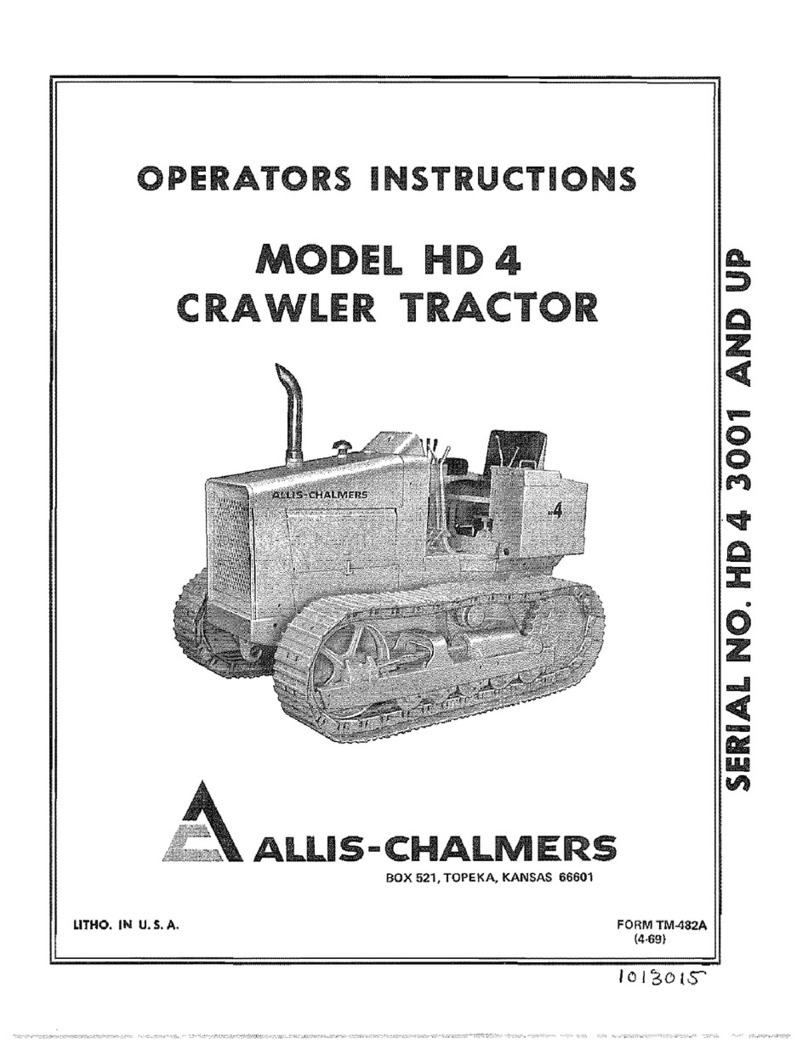
Allis-Chalmers
Allis-Chalmers HD-4 Specifications
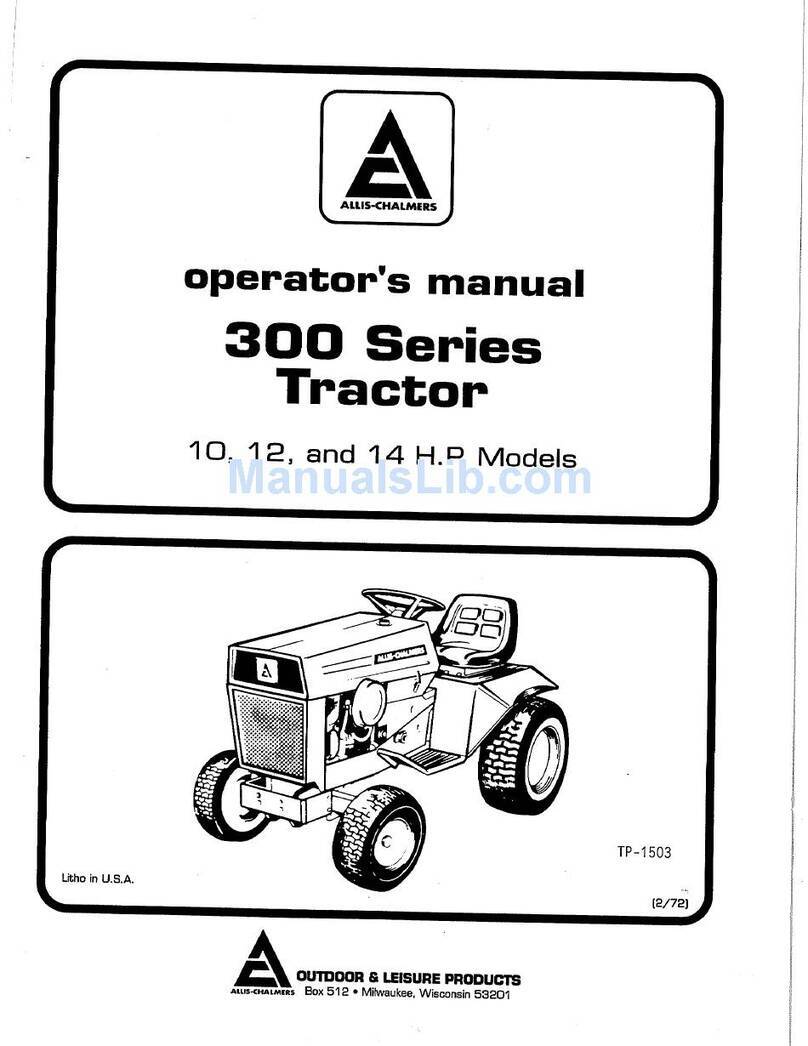
Allis-Chalmers
Allis-Chalmers 10 hp User manual
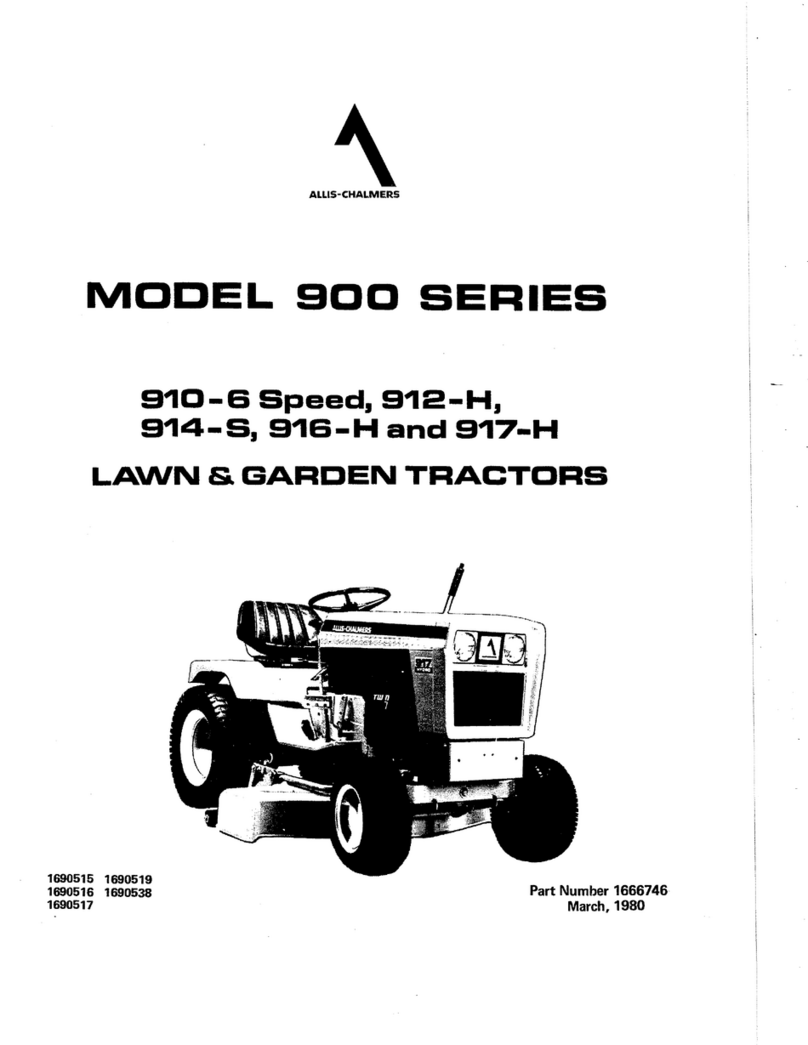
Allis-Chalmers
Allis-Chalmers 910-6 Speed User manual
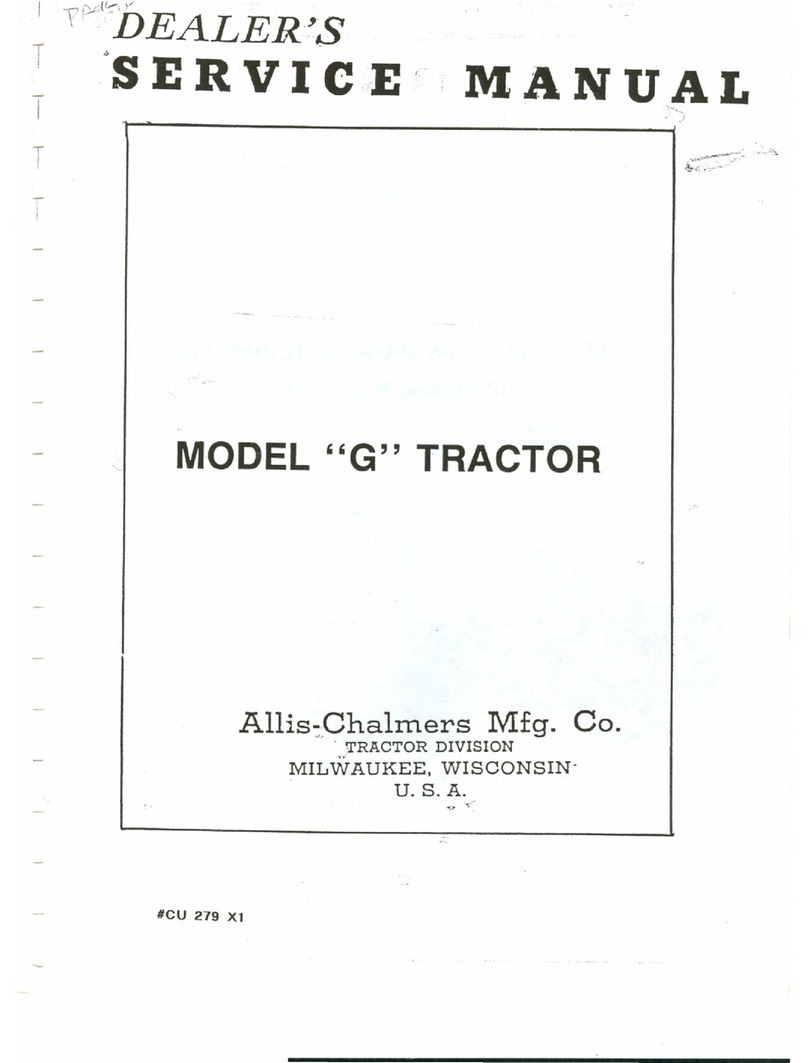
Allis-Chalmers
Allis-Chalmers G User manual
